Emily Lakdawalla • Aug 19, 2009
What's up in the solar system in August 2009
Time to step back and take stock of what's going on with all our favorite robotic missions exploring space beyond Earth.... NASA's MESSENGER is now closing in on its third and final flyby of Mercury, coming up on September 29. Its view of Mercury will be very similar to the October 2008 one, so a complementary set of observations is planned. MESSENGER is on its way to Mercury orbit insertion on March 18, 2011.
NASA's MESSENGER is now closing in on its third and final flyby of Mercury, coming up on September 29. Its view of Mercury will be very similar to the October 2008 one, so a complementary set of observations is planned. MESSENGER is on its way to Mercury orbit insertion on March 18, 2011.
 ESA's Venus Express is still in orbit at Venus; its current mission extension runs out on December 31, 2009, but the mission is expected to receive another extension in October taking it through three more years. If it remains healthy, it should therefore still be operating when JAXA's "Planet-C" Venus Climate Orbiter arrives in 2011.
ESA's Venus Express is still in orbit at Venus; its current mission extension runs out on December 31, 2009, but the mission is expected to receive another extension in October taking it through three more years. If it remains healthy, it should therefore still be operating when JAXA's "Planet-C" Venus Climate Orbiter arrives in 2011.
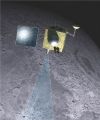 While I was away from work, India's Chandrayaan-1 moon orbiter suffered a major setback, the failure of its star sensors. It has been moved to a higher orbit (200 kilometers as opposed to 100 kilometers) and is now accomplishing its pointing using gyroscopes. Chandrayaan-1 mission controllers have informed the other space agencies with instruments on Chandrayaan-1 that they should plan to complete their data collection by January 2010, as "they cannot take for granted" the operation of the spacecraft beyond that. Chandrayaan-1 launched in October 2008, and was to have operated for two years.
While I was away from work, India's Chandrayaan-1 moon orbiter suffered a major setback, the failure of its star sensors. It has been moved to a higher orbit (200 kilometers as opposed to 100 kilometers) and is now accomplishing its pointing using gyroscopes. Chandrayaan-1 mission controllers have informed the other space agencies with instruments on Chandrayaan-1 that they should plan to complete their data collection by January 2010, as "they cannot take for granted" the operation of the spacecraft beyond that. Chandrayaan-1 launched in October 2008, and was to have operated for two years.
 Also at the Moon now is NASA's Lunar Reconnaissance Orbiter. LRO is still in its commissioning phase and should achieve its final science orbit on September 15. In the meantime it's been returning some fantastic images. I promise I will get to a post on those images soon!
Also at the Moon now is NASA's Lunar Reconnaissance Orbiter. LRO is still in its commissioning phase and should achieve its final science orbit on September 15. In the meantime it's been returning some fantastic images. I promise I will get to a post on those images soon!
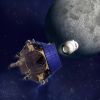 NASA's LCROSS is in a long looping orbit of the Moon, gearing up for its October 9 impact.
NASA's LCROSS is in a long looping orbit of the Moon, gearing up for its October 9 impact.
 Out at Mars, it's late summer in Mars' southern hemisphere (Ls 324°). It's a celebratory time on NASA's Mars Exploration Rover mission: Spirit has now survived to 2,000 sols. Spirit's engineers are still working, slowly but steadily, on extracting the rover from a site named "Troy," in which it has been buried up to its hubcaps. The place to follow that action is JPL's "Free Spirit" website. According to that site, the engineering model of the rover is currently undergong a long-duration test that "will check whether favorable motion seen in earlier tests can be sustained to gain as much distance in the sandbox as Spirit would need to complete on Mars to escape its predicament." Meanwhile, Opportunity has been taking a break from its sustained drive toward Endeavour crater in order to examine a huge meteorite named "Block Island."
Out at Mars, it's late summer in Mars' southern hemisphere (Ls 324°). It's a celebratory time on NASA's Mars Exploration Rover mission: Spirit has now survived to 2,000 sols. Spirit's engineers are still working, slowly but steadily, on extracting the rover from a site named "Troy," in which it has been buried up to its hubcaps. The place to follow that action is JPL's "Free Spirit" website. According to that site, the engineering model of the rover is currently undergong a long-duration test that "will check whether favorable motion seen in earlier tests can be sustained to gain as much distance in the sandbox as Spirit would need to complete on Mars to escape its predicament." Meanwhile, Opportunity has been taking a break from its sustained drive toward Endeavour crater in order to examine a huge meteorite named "Block Island."
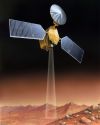 Mars Reconnaissance Orbiter had a brief hiccup this month, switching over to its backup computer systems, but normal operations were restored on August 10. You can see all the latest images from Mars Reconnaissance Orbiter here, and the latest weather reports from the MARCI team here. The CRISM team seems to have run out of steam on image releases -- there's been nothing new since late in 2008.
Mars Reconnaissance Orbiter had a brief hiccup this month, switching over to its backup computer systems, but normal operations were restored on August 10. You can see all the latest images from Mars Reconnaissance Orbiter here, and the latest weather reports from the MARCI team here. The CRISM team seems to have run out of steam on image releases -- there's been nothing new since late in 2008.
 ESA's Mars Express is also still diligently mapping Mars. Recently, the Mars Express images were added to ASU's wonderful Mars global data search website -- that really has become a one-stop shop for Mars data. Meanwhile, the Mars Webcam is currently returning high-phase shots of Mars. The latest image release to hit the ESA website is a lovely one showing all kinds of fluvial and volcanic textures near Ma'adim Vallis. Mars Express' current mission extension takes it through December 31 -- again, it's expected to be extended further.
ESA's Mars Express is also still diligently mapping Mars. Recently, the Mars Express images were added to ASU's wonderful Mars global data search website -- that really has become a one-stop shop for Mars data. Meanwhile, the Mars Webcam is currently returning high-phase shots of Mars. The latest image release to hit the ESA website is a lovely one showing all kinds of fluvial and volcanic textures near Ma'adim Vallis. Mars Express' current mission extension takes it through December 31 -- again, it's expected to be extended further.
 NASA's Mars Odyssey remains the longest-lived spacecraft in orbit at Mars. You can see the latest from its THEMIS instrument here. While I was away, they completed the shift in Odyssey's orbit to one that sees the Martian surface at about 3:45 p.m. local time; its earlier orbit was a 5 pm one. That change will produce much better infrared data from THEMIS, which should lead to a swath of new papers on the composition of the Martian surface.
NASA's Mars Odyssey remains the longest-lived spacecraft in orbit at Mars. You can see the latest from its THEMIS instrument here. While I was away, they completed the shift in Odyssey's orbit to one that sees the Martian surface at about 3:45 p.m. local time; its earlier orbit was a 5 pm one. That change will produce much better infrared data from THEMIS, which should lead to a swath of new papers on the composition of the Martian surface.
 The big news at Saturn this month is, of course, the equinox, which the NASA-ESA-ASI mission Cassini mission has been studying with all instruments. Cassini is now wrapping up rev 116 of its tour; its orbits currently last 16 days -- one for every Titan orbit -- so it meets Titan once every single time it orbits Saturn. That's been the situation for the last 9 orbits, as Cassini has been in a high-inclination orbit to watch the equinox and the effects that it has on the rings and planet. The 10th and last encounter-Titan-every-time flyby happens on August 25. That flyby will kick Cassini into a longer, 24-day orbit and will begin the process of changing the orbit to one that will lie much closer to Saturn's ring plane, allowing frequent close encounters of the icy moons beginning in September. The next big event to look forward to is two super-close flybys of the geyser moon Enceladus, planned for November 2 and November 21.
The big news at Saturn this month is, of course, the equinox, which the NASA-ESA-ASI mission Cassini mission has been studying with all instruments. Cassini is now wrapping up rev 116 of its tour; its orbits currently last 16 days -- one for every Titan orbit -- so it meets Titan once every single time it orbits Saturn. That's been the situation for the last 9 orbits, as Cassini has been in a high-inclination orbit to watch the equinox and the effects that it has on the rings and planet. The 10th and last encounter-Titan-every-time flyby happens on August 25. That flyby will kick Cassini into a longer, 24-day orbit and will begin the process of changing the orbit to one that will lie much closer to Saturn's ring plane, allowing frequent close encounters of the icy moons beginning in September. The next big event to look forward to is two super-close flybys of the geyser moon Enceladus, planned for November 2 and November 21.
![]() In the asteroid belt, NASA's Dawn has resumed steady thrusting of its ion engines, patiently propelling itself toward a rendezvous with Vesta in August 2011.
In the asteroid belt, NASA's Dawn has resumed steady thrusting of its ion engines, patiently propelling itself toward a rendezvous with Vesta in August 2011.
 NASA's Deep Impact is cruising toward its 2010 flyby of comet 103P/Hartley 2. Mission scientists are hard at work using the world's great observatories, including Spitzer, Hubble, and Gemini, to learn as much as possible about 103P/Hartley 2 beore Deep Impact arrives.
NASA's Deep Impact is cruising toward its 2010 flyby of comet 103P/Hartley 2. Mission scientists are hard at work using the world's great observatories, including Spitzer, Hubble, and Gemini, to learn as much as possible about 103P/Hartley 2 beore Deep Impact arrives.
 NASA's Stardust is cruising ever onward toward a Feburary 14, 2011 encounter with comet Tempel 1. The latest status report, from July, indicates the spacecraft is in good health.
NASA's Stardust is cruising ever onward toward a Feburary 14, 2011 encounter with comet Tempel 1. The latest status report, from July, indicates the spacecraft is in good health.
 JAXA's Hayabusa has been in powered flight since February, still working on returning to Earth. This month Hayabusa has been in solar conjunction, where the spacecraft goes behind the Sun as seen from Earth; the mission has been taking advantage of the geometry to do radio occultation experiments to probe the structure of the outermost layers of the Sun.
JAXA's Hayabusa has been in powered flight since February, still working on returning to Earth. This month Hayabusa has been in solar conjunction, where the spacecraft goes behind the Sun as seen from Earth; the mission has been taking advantage of the geometry to do radio occultation experiments to probe the structure of the outermost layers of the Sun.
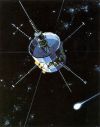 I don't have any new information on the International Cometary Explorer but I assume it's still on course for a return visit to Earth in 2014.
I don't have any new information on the International Cometary Explorer but I assume it's still on course for a return visit to Earth in 2014.
 There's been no news on ESA's Rosetta mission website since October of 2008. Its third and final flyby of Earth is coming up soon, on November 13; the next big science event for Rosetta will be the flyby of asteroid Lutetia in July of 2010.
There's been no news on ESA's Rosetta mission website since October of 2008. Its third and final flyby of Earth is coming up soon, on November 13; the next big science event for Rosetta will be the flyby of asteroid Lutetia in July of 2010.
 The ESA/NASA SOHO mission continues to gaze at a very quiet Sun. As always, SOHO's near-real-time data and images are available here, and a report on current space weather is available from NOAA here.
The ESA/NASA SOHO mission continues to gaze at a very quiet Sun. As always, SOHO's near-real-time data and images are available here, and a report on current space weather is available from NOAA here.
 The twin STEREO spacecraft are currently 58 degrees ahead (STEREO A) and 52 degrees behind (STEREO B) Earth and are also enjoying quiet weather conditions. The daily STEREO image viewer includes the latest SOHO image, which gives you three slightly different viewpoints on the current appearance of the Sun.
The twin STEREO spacecraft are currently 58 degrees ahead (STEREO A) and 52 degrees behind (STEREO B) Earth and are also enjoying quiet weather conditions. The daily STEREO image viewer includes the latest SOHO image, which gives you three slightly different viewpoints on the current appearance of the Sun.
 NASA's New Horizons is just about at the midway point between the orbits of Saturn and Uranus (it'll reach that point on September 8). It has 17.55 AU to go to reach Pluto. According to their Twitter page, New Horizons is now slower than the Voyagers, though it's still on a trajectory that will exit the solar system. It's still on course for a July and August 2015 encounter with the Pluto and Charon system.
NASA's New Horizons is just about at the midway point between the orbits of Saturn and Uranus (it'll reach that point on September 8). It has 17.55 AU to go to reach Pluto. According to their Twitter page, New Horizons is now slower than the Voyagers, though it's still on a trajectory that will exit the solar system. It's still on course for a July and August 2015 encounter with the Pluto and Charon system.
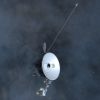 Finally, NASA's Voyager 1 and 2 spacecraft were still responding to commands from Earth as of June 24. Both have now crossed the "termination shock," where the solar wind slows down as it impinges upon the interstellar medium.
Finally, NASA's Voyager 1 and 2 spacecraft were still responding to commands from Earth as of June 24. Both have now crossed the "termination shock," where the solar wind slows down as it impinges upon the interstellar medium.
Some other milestones to take note of this month:
- The 3rd was the 5th anniversary of MESSENGER's launch.
- On the 14th, Jupiter was at opposition -- it's a beautiful bright "star" high in the sky at night.
- On the 17th, Neptune was also at opposition.
- Yesterday, the 18th, the Moon occulted Vesta.
- Yesterday, the 18th, was the 10th anniversary of Cassini's flyby of Earth.
- The space shuttle Discovery is expected to launch on August 24 on the STS-128 mission to the ISS.
- Also on August 24, Mercury will be at its greatest eastern elongation.
- August 25 will see the 20th anniversary of Voyager 2's flyby of Neptune.
The Time is Now.
As a Planetary Defender, you’re part of our mission to decrease the risk of Earth being hit by an asteroid or comet.
Donate Today

 Explore Worlds
Explore Worlds Find Life
Find Life Defend Earth
Defend Earth

